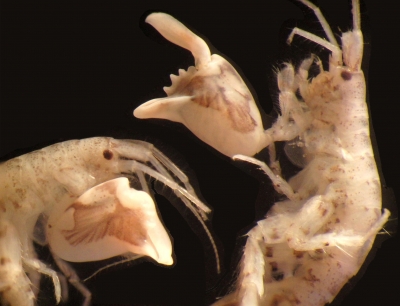
The fastest snapping claws on Earth belong to male amphipods (Dulichiella cf. appendiculata). These microscopic, shrimp-like creatures, repeatedly close their claws thousands of times per second. The claws make audible popping sounds and generate water jets with each snap. Some of the jets are so intense, they result in a phenomenon called cavitation, when rapid changes in pressure create bubbles in the water.
The claw, which only occurs on one side in males, is impressive, reaching 30% of an adult’s body mass. Its ultrafast closing makes an audible snap, creating water jets and sometimes producing small bubbles due to rapid changes in water pressure, a phenomenon known as cavitation.
Three things make this ultra-fast movement unique said Sarah Longo, who studied the amphipods as part of her postdoctoral studies at Duke: the amphipods’ really small size, the fact that they live in water, and the repeatability of their movements.
Other animals have comparable accelerations, but none has the same set of constraints: the jaws of trap-jaw ants are faster, but move through air. Mantis shrimp are comparably fast and aquatic, but much larger. Jellyfish stinging cells are ejected with higher acceleration, but only once.
Picture Credit : Google




